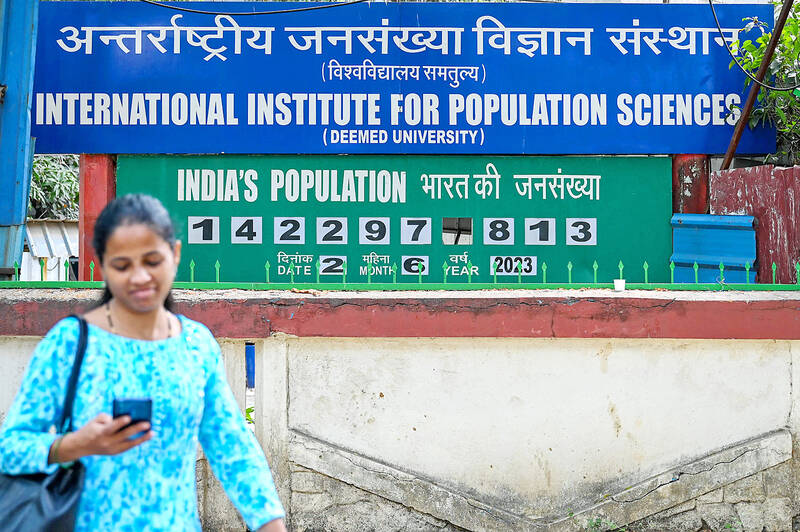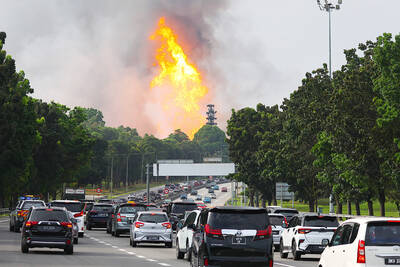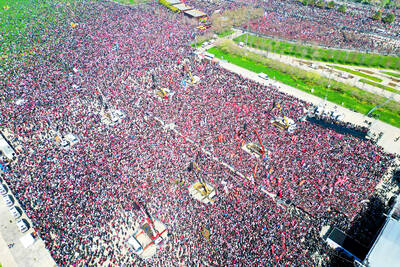India’s first population clock, made up of 10 white numbered cards on a large green metal board, attracts curious passersby who watch it record the story of the world’s most populous nation.
The clock — manually updated every day according to projected estimates, and akin to a cricket scoreboard in appearance — was erected in 1982 when India was home to more than 684 million people, according to the 1981 government census.
That figure more than doubled in the following decades. India grew rapidly to overtake China at the top of the population ranks with more than 1.42 billion people, the UN said in April.

Photo: AFP
“An extra slot had already been made in the clock, expecting that we were going to cross 1 billion,” International Institute for Population Sciences professor Chander Shekhar said in Mumbai, where the clock is.
Overpopulation has long been a concern, with the government establishing a nationwide family planning program in 1952.
However, it was a controversial enforced-sterilization push in the 1970s that sparked public debates and spurred the institute to create the clock, Shekhar said.
Every day, security guards change the numbers using projections of the natural growth rate — the difference between the number of births and the number of deaths per 1,000 a year — derived from government and UN estimates.
“We feel good when we update the board, as passersby can also see the growing population numbers,” 56-year-old security supervisor Salunkhe V.V. said.
The projections estimate that India’s population increases by just under 41,000 people per day — one every two seconds — or about 15 million per year.
India’s fertility rate is two births per woman, just under the replacement threshold of 2.1, and down from government estimates of 4.8 in 1981.
The fertility rate varies across the country, with poorer states such as Uttar Pradesh and Bihar — boasting a combined population of more than 325 million — having the highest rates, a 2019 government survey showed.
In contrast, the two wealthiest states of Maharashtra and Tamil Nadu have fertility rates of 1.56 and 1.54 respectively, far below the average, the survey showed.
Family planning has largely been left to women, with less than one in 10 men using condoms, while female sterilization was at nearly 38 percent, India’s 2019 to 2021 family health survey showed.
Shekhar, 49, was drawn to studying population from a young age, fascinated and “agitated” by large crowds of people everywhere he went.
“I used to hate these numbers,” Shekhar said. “But after I got my master’s in statistics, I thought, ‘Let us understand this, is it a problem? Or can it really be solved?’”
Shekhar said the large numbers do not have to be a ticking time bomb if authorities focus on raising people’s quality of life.
Education and health outcomes — such as falling infant and maternal mortality rates — have improved since 1982, and India’s economy has grown to the fifth-largest in the world.
However, in many cities, residents battle for resources while facing water shortages and air and water pollution.
Youth unemployment for the ages of 15 to 24 stood at 23.2 percent last year, the World Bank said.
The overall jobless rate was 7.7 percent in May, Centre for Monitoring Indian Economy data showed.
Shekhar said a key concern was that “India will become older before it becomes richer.”
“For that [not to happen], we need to have people be skilled, and have employment opportunities for a huge, young, bulge of population,” he said.

A fire caused by a burst gas pipe yesterday spread to several homes and sent a fireball soaring into the sky outside Malaysia’s largest city, injuring more than 100 people. The towering inferno near a gas station in Putra Heights outside Kuala Lumpur was visible for kilometers and lasted for several hours. It happened during a public holiday as Muslims, who are the majority in Malaysia, celebrate the second day of Eid al-Fitr. National oil company Petronas said the fire started at one of its gas pipelines at 8:10am and the affected pipeline was later isolated. Disaster management officials said shutting the

US Vice President J.D. Vance on Friday accused Denmark of not having done enough to protect Greenland, when he visited the strategically placed and resource-rich Danish territory coveted by US President Donald Trump. Vance made his comment during a trip to the Pituffik Space Base in northwestern Greenland, a visit viewed by Copenhagen and Nuuk as a provocation. “Our message to Denmark is very simple: You have not done a good job by the people of Greenland,” Vance told a news conference. “You have under-invested in the people of Greenland, and you have under-invested in the security architecture of this

Japan unveiled a plan on Thursday to evacuate around 120,000 residents and tourists from its southern islets near Taiwan within six days in the event of an “emergency”. The plan was put together as “the security situation surrounding our nation grows severe” and with an “emergency” in mind, the government’s crisis management office said. Exactly what that emergency might be was left unspecified in the plan but it envisages the evacuation of around 120,000 people in five Japanese islets close to Taiwan. China claims Taiwan as part of its territory and has stepped up military pressure in recent years, including

UNREST: The authorities in Turkey arrested 13 Turkish journalists in five days, deported a BBC correspondent and on Thursday arrested a reporter from Sweden Waving flags and chanting slogans, many hundreds of thousands of anti-government demonstrators on Saturday rallied in Istanbul, Turkey, in defence of democracy after the arrest of Istanbul Mayor Ekrem Imamoglu which sparked Turkey’s worst street unrest in more than a decade. Under a cloudless blue sky, vast crowds gathered in Maltepe on the Asian side of Turkey’s biggest city on the eve of the Eid al-Fitr celebration which started yesterday, marking the end of Ramadan. Ozgur Ozel, chairman of the main opposition Republican People’s Party (CHP), which organized the rally, said there were 2.2 million people in the crowd, but